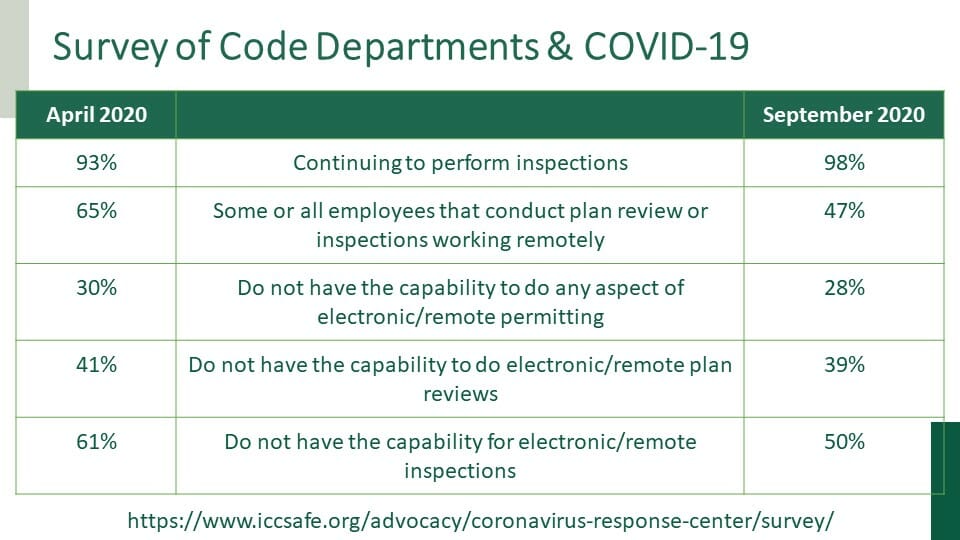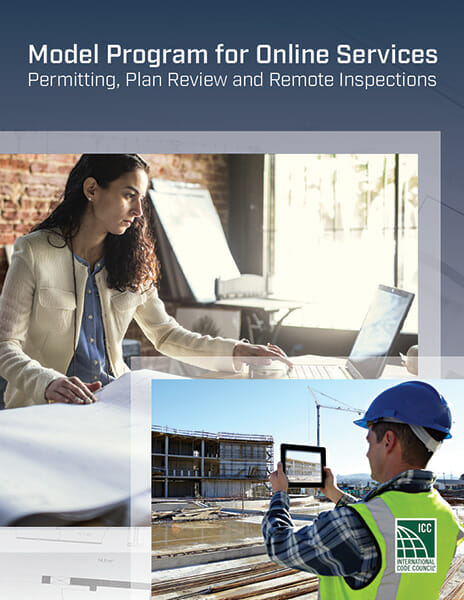The Growth of Remote Virtual Inspections

About the Author: Ryan M. Colker is Vice President, Innovation, at the International Code Council.
The COVID-19 pandemic has brought lots of change to the construction industry—particularly for building code and fire safety departments. Most states and the federal government declared code administration and enforcement essential services. However, many departments were faced with the need to implement new policies and procedures to assure their work could continue safely.
The International Code Council conducted a survey of code departments in March and April of 2020 to gauge their virtual capabilities. Based on over 1,150 responses from all 50 states and Washington, DC, the survey found that the majority of departments (93%) were still doing inspections either remotely or in person. About two-thirds (65%) of jurisdictions reported that some or all employees that conduct plan review or inspections are working remotely. While many jurisdictions made the switch to electronic processes, a large percentage still did not have the capacity to go virtual—for example, 61% did not have the capability to do electronic or remote inspections.1

In August and September 2020, the Code Council again surveyed code departments to see how their processes and practices changed given a little time to adapt. By September nearly all departments were performing inspections (98% versus 93% in April) while nearly half still had key staff working remotely (47% versus 65% in April). In September 53% of departments still did not have the capability to do remote virtual inspections (down from 61% in April).
While remote virtual inspection (RVI) was seen by many as an opportunity to reduce exposure to the virus, many departments were unsure of where to start. Some larger jurisdictions including Los Angeles City and County and North Las Vegas, Nevada already had virtual inspection programs for many small or routine projects and were willing to share their lessons learned with others. Smaller, rural jurisdictions like Miami, Ohio were using remote virtual inspections to cut down on travel times. The Code Council produced a series of documents and held webinars to help provide guidance and get departments up to speed.2 The most recent publication, Model Program for Online Services: Permitting, Plan Review and Remote Inspections, captures best practices from building officials, industry professionals and inspection agencies.3
Remote virtual inspections and off-site construction
The two Code Council surveys primarily captured results in the context of inspections at the job site, but could provide insight into the potential for growth in remote virtual inspections for off-site construction. As code departments become more comfortable with the technology that comfort may spread to state industrialized building programs. The recently released off-site construction standards developed by the Code Council and the Modular Building Institute (MBI) allows for the use of remote virtual inspections at the discretion of the Authority Having Jurisdiction.4
One off-site construction project taking advantage of remote virtual inspection is a 296-room, 105-foot-tall modular citizenM hotel going up in Washington, DC. As COVID-19 threatened to slow construction, the hotel chain, local development manager Altus Realty and third party inspection agency ICC-NTA looked for solutions to mitigate the risk. They approached the District’s Department of Consumer and Regulatory Affairs (DCRA) about the possibility of using remote virtual inspection within the factory in Poland. After a few practice inspections to test out the technology and to ensure DCRA and NTA approved of the procedures, a formal all-virtual inspection process was underway. To assure the same level of quality and compliance as an on-site inspection, NTA personnel developed remote virtual inspection procedures that mirrored NTA’s in-plant inspection procedures and the DCRA Third-Party Program Procedure Manual requirements.

In addition to ramping up the virtual inspection program at NTA the manufacturer also needed to prepare for the virtual inspection process. Quality assurance personnel were assigned to assist with inspections. In advance of the inspection on-site personnel provide NTA with copies of all material listings for each module. During the inspection plant personnel show the serial number for the unit being inspected and walk through an inspection checklist with the NTA inspector. Close ups or more focused videos can be requested by the NTA inspector.
Using the remote virtual inspection process NTA inspectors can monitor testing of modules including water testing of window installation, pressure testing of plumbing systems and other important procedures.
While it took some getting used to for the inspectors, a good rapport with the quality assurance personnel in the factory and comfort on the part of DCRA with the protocols put in place by NTA, the remote virtual inspection process provided some valuable lessons for the project team and may open opportunities for further use of remote virtual inspections in the future.
Endnotes
1 International Code Council, Building Safety and COVID-19: Analysis of U.S. Code Department Responses to the Pandemic. July 1, 2020. https://www.iccsafe.org/wp-content/uploads/20-18952_GR_Survey_Analysis_RPT_FINAL_HIRES.pdf
2 See https://www.iccsafe.org/advocacy/coronavirus-response-center/virtual/ for access to virtual resources.
3 International Code Council, Model Program for Online Services: Permitting, Plan Review and Remote Inspections. April 2021. https://shop.iccsafe.org/model-program-for-online-services-permitting-plan-review-and-remote-inspections.html
4 ICC/MBI 1205-2021 Standard for Off-Site Construction: Inspection and Regulatory Compliance, Section 301.2. https://codes.iccsafe.org/content/ICC12052021P1/chapter-3-plan-approvals-and-inspection-procedures
More from Modular Advantage
AoRa Development Aims for New York’s First Triple Net Zero Building Using Modular Methods
More cities are providing funding for newer infrastructure projects as long as they meet sustainability requirements. This is how modular can fit the bill, thanks to its lower waste production.
Developers and Designers: Lessons Learned with Modular Design
Modular construction is attractive to many developers because sitework and module construction can occur simultaneously, shortening the schedule and reducing additional costs.
UTILE: Putting Modular Building on a Fast Track
In Quebec, UTILE is taking the lead in creating affordable modular buildings to help decrease the student housing shortage. During the process, the company discovered what it takes to make the transition to modular building a success.
Sobha Modular Teaches Developers How to Think Like Manufacturers
With its 2.7 million square foot factory in UAE, Sobha Modular is bringing both its high-end bathroom pods to high-end residences to Dubai while developing modular projects for the U.S. and Australia.
RoadMasters: Why Early Transport Planning is Make-or-Break in Modular Construction
In modular construction, transportation is often called the “missing link.” While it rarely stops a project outright, poor planning can trigger costly delays, rerouting, and budget overruns.
Navigating Risk in Commercial Real Estate and Modular Construction: Insights from a 44-Year Industry Veteran
Modular projects involve manufacturing, transportation, and on-site assembly. Developers must understand exactly what they are responsible for versus what they subcontract. Risk advisors should research the developer’s contractors, subcontractors, and design-build consultants—especially the modular manufacturer.
Art²Park – A Creative Application of Modular and Conventional Construction
Art²Park is more than a park building—it’s a demonstration of what modular construction can achieve when thoughtfully integrated with traditional materials. The use of shipping containers provided not only speed and sustainability benefits but also a powerful structural core that simplified and strengthened the rest of the building.
Building Smarter: A New Standard in Modular Construction Efficiency
Rising material prices, labour shortages, expensive financing and tightening environmental rules have made conventional construction slower, costlier, and more unpredictable. To keep projects on schedule and within budget, builders are increasingly turning to smarter industrialized methods.
Resia: Breaking All the Rules
Resia Manufacturing, a division of U.S.-based Resia, is now offering prefabricated bathroom and kitchen components to industry partners. Its hybrid fabrication facility produces more precise bathroom and kitchen components (modules) faster and at lower cost than traditional construction. Here’s how Resia Manufacturing does it.
How LINQ Modular Innovates to Bring Modular To The Market in the UAE and Beyond
LINQ Modular, with an office and three manufacturing facilities in Dubai, is a modular firm based in United Arab Emirates. The company is on a mission: to break open the housing and construction markets in the Gulf Cooperation Council (GCC) area with modular.










